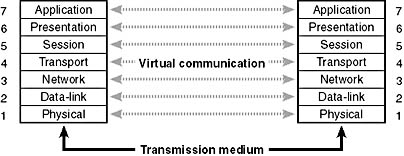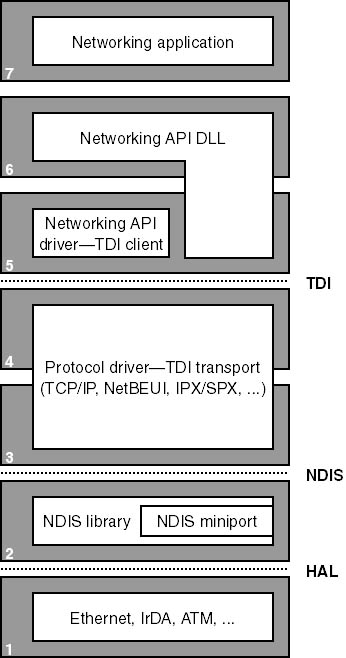The OSI Reference Model
The goal of network software is to take a request (usually an I/O request) from an application on one machine, pass it to another machine, execute the request on the remote machine, and return the results to the first machine. In the course of this process, the request must be transformed several times along the way. A high-level request, such as "read x number of bytes from file y on machine z," requires software that can determine how to get to machine z and what communication software that machine understands. Then the request must be altered for transmission across a network—for example, divided into short packets of information. When the request reaches the other side, it must be checked for completeness, decoded, and sent to the correct operating system component for execution. Finally, the reply must be encoded for sending back across the network.
To help different computer manufacturers standardize and integrate their networking software, in 1974 the International Organization for Standardization (ISO) defined a software model for sending messages between machines. The result is the Open Systems Interconnection (OSI) reference model. The model defines seven layers of software, as shown in Figure 13-1.

Figure 13-1 OSI reference model
The OSI reference model is an idealized scheme that few systems implement precisely, but it's often used to frame discussions of networking principles. Each layer on one machine assumes that it is "talking to" the same layer on the other machine. Both machines "speak" the same language, or protocol, at the same level. In reality, however, a network transmission must pass down each layer on the client machine, be transmitted across the network, and then pass up the layers on the destination machine until it reaches a layer that can understand and implement the request.
OSI Layers
The purpose of each layer in the OSI model is to provide services to higher layers and to abstract how the services are implemented at lower layers. Detailing the purpose of each layer is beyond the scope of this book, but here are some brief descriptions of the various layers:
- Application layer Handles information transfer between two network applications, including functions such as security checks, identification of the participating machines, and initiation of the data exchange.
- Presentation layer Handles data formatting, including issues such as whether lines end in carriage return/line feed (CR/LF) or just carriage return (CR), whether data is to be compressed or encoded, and so forth.
- Session layer Manages the connection between cooperating applications, including high-level synchronization and monitoring of which application is "talking" and which is "listening."
- Transport layer On the client, this layer divides messages into packets and assigns them sequence numbers to ensure that they are all received in the proper order. On the destination, it assembles packets that have been received. It also shields the session layer from the effects of changes in hardware.
- Network layer Creates packet headers and handles routing, congestion control, and internetworking. It is the highest layer that understands the network's topology, that is, the physical configuration of the machines in the network, any limitations in bandwidth, and so on.
- Data-link layer Transmits low-level data frames, waits for acknowledgment that they were received, and retransmits frames that were lost over unreliable lines.
- Physical layer Passes bits to the network cable or other physical transmission medium.
The dashed lines in Figure 13-1 represent protocols used in transmitting a request to a remote machine. As stated earlier, each layer of the hierarchy assumes that it is speaking to the same layer on another machine and uses a common protocol. The collection of protocols through which a request passes on its way down and back up the layers of the network is called a protocol stack.
Windows 2000 Networking Components
Figure 13-2 provides an overview of the components of Windows 2000 networking, showing how each component fits into the OSI reference model and which protocols are used between layers. The mapping between OSI layers and networking components isn't precise, which is the reason that some components cross layers. The various components include the following:
- Networking APIs provide a protocol-independent way for applications to communicate across a network. Networking APIs can be implemented in user mode or in both user mode and kernel mode, and in some cases are wrappers around another networking API that implements a specific programming model or provides additional services. (Note that the term networking API also describes any programming interfaces provided by networking-related software.)
- Transport Driver Interface (TDI) clients are kernel-mode device drivers that usually implement the kernel-mode portion of a networking API's implementation. TDI clients get their name from the fact that the I/O request packets (IRPs) they send to protocol drivers are formatted according to the Windows 2000 Transport Driver Interface standard (documented in the DDK). This standard specifies a common programming interface for kernel-mode device drivers. (See Chapter 9 for more information about IRPs.)
- TDI transports, also known as transports, Network Driver Interface Specification (NDIS) protocol drivers, and protocol drivers, are kernel-mode protocol drivers. They accept IRPs from TDI clients and process the requests these IRPs represent. This processing might require network communications with a peer, prompting the TDI transport to add protocol-specific headers (such as TCP, UDP, IPX) to data passed in the IRP and to communicate with adapter drivers using NDIS functions (also documented in the DDK). TDI transports generally facilitate application network communications by transparently performing message operations such as segmentation and reassembly, sequencing, acknowledgment, and retransmission.
- The NDIS library (Ndis.sys) provides encapsulation for adapter drivers, hiding from them specifics of the Windows 2000 kernel-mode environment. The NDIS library exports functions for use by TDI transports as well as support functions for adapter drivers.
- NDIS miniport drivers are kernel-mode drivers that are responsible for interfacing TDI transports to particular network adapters. NDIS miniport drivers are written so that they are wrapped by the Windows 2000 NDIS library. The encapsulation provides cross-platform compatibility with Consumer Windows. NDIS miniport drivers don't process IRPs; rather, they register a call-table interface to the NDIS library that contains pointers to functions corresponding to ones that the NDIS library exports to TDI transports. NDIS miniport drivers communicate with network adapters by using NDIS library functions that resolve to hardware abstraction layer (HAL) functions.
As the figure shows, the OSI layers don't correspond to actual software. TDI transports, for example, frequently cross several boundaries. In fact, the bottom four layers of software are often referred to collectively as "the transport." Software components residing in the upper three layers are referred to as "users of the transport."

Figure 13-2 OSI model and Windows 2000 networking components
In the remainder of this chapter, we'll examine the networking components shown in Figure 13-2 (as well as others not shown in the figure), looking at how they fit together and how they relate to Windows 2000 as a whole.
EAN: 2147483647
Pages: 121